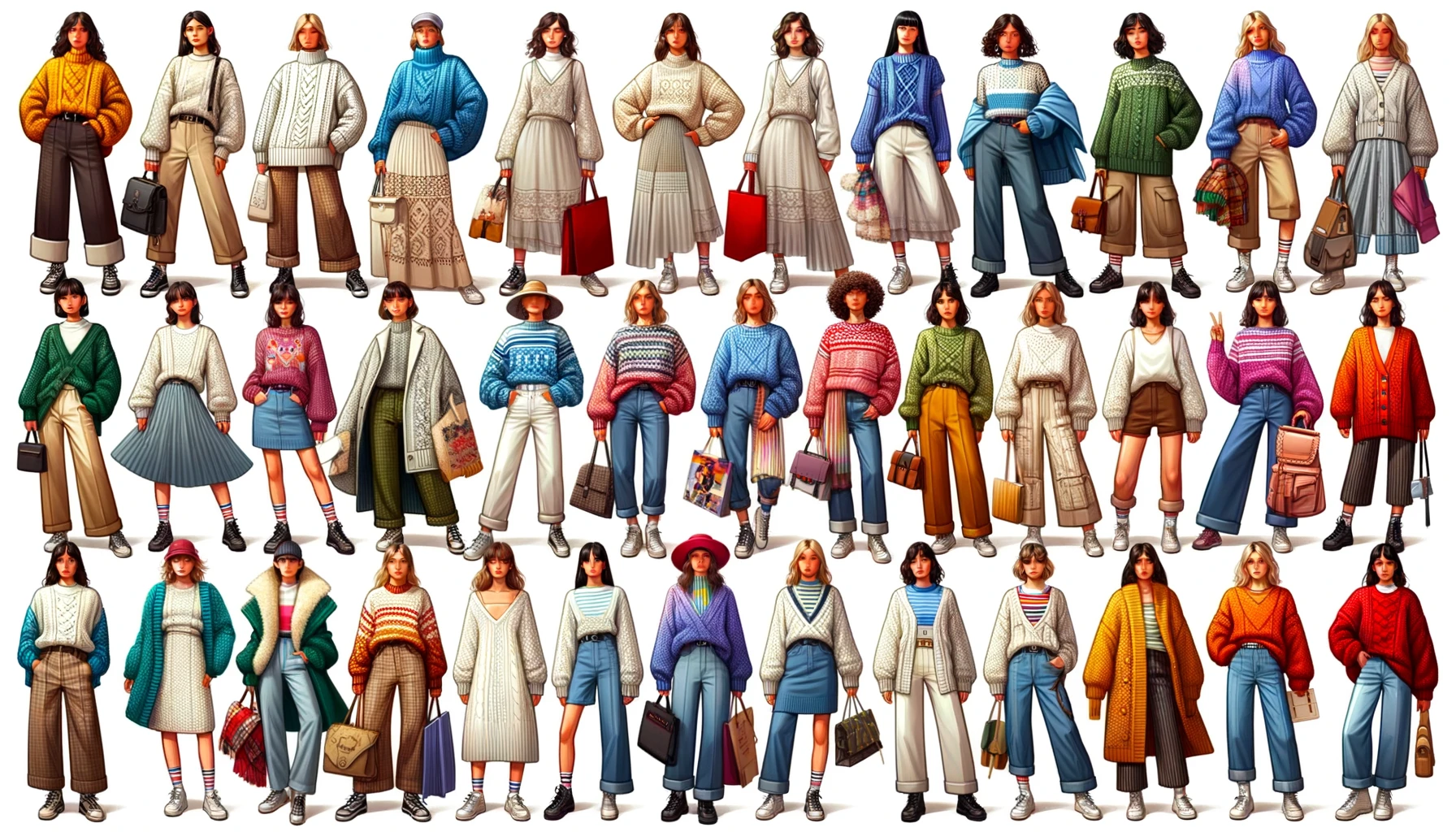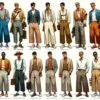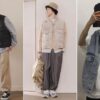The Jump into Jumpers: Styles, Pairings, and Endless Versatility
The concept of a “jumper” in fashion exhibits fascinating diversity across cultures, reflecting different styles, materials, and occasions. Understanding this garment’s versatility can significantly enrich one’s wardrobe choices.

I. Defining the Jumper
- In British Context: Here, a jumper is essentially a long-sleeve sweater, crafted from a variety of materials including wool, fleece, and cotton. This versatility in fabric choice allows for a range of thickness and warmth, catering to different climates and personal preferences. The design spectrum is broad, featuring everything from solid colors and simple cuts to intricate patterns and unique textures.

- In American Vernacular: Contrasting with the British version, the American jumper is a sleeveless, collarless dress designed to be worn over a blouse or shirt, similar to a pinafore. This style of jumper often features elements like front buttons or decorative embroidery, lending itself to both casual and semi-formal settings.
II. Top 5 Stylish Ways to Pair a Jumper
With a Long Coat: The combination of a turtleneck jumper and a long coat stands as a testament to the fusion of functionality and fashion. This pairing is particularly appealing in colder climates, where the layered approach not only traps heat efficiently but also allows for a play of textures and lengths.

With Chinos and Sports Shoes: For a look that balances casual comfort with a touch of sophistication, pairing a jumper with chinos and sports shoes is ideal. This ensemble works well for a variety of occasions, bridging the gap between relaxed and formal attire.

With Shorts: Targeting the transitional weather of autumn, combining a jumper with shorts offers a stylish solution. This pairing balances the warmth of the jumper with the casual, breezy nature of shorts, perfect for days when the weather is cool but not cold.

With a Denim Jacket: Embracing a classic, rugged aesthetic, a jumper beneath a denim jacket creates a timeless look. This combination is particularly popular among men, offering a straightforward yet stylish option that pairs well with various types of jeans and footwear.

With a White Shirt and Jeans: For a minimalist approach that doesn’t compromise on style, wearing a jumper over a crisp white shirt, complemented by jeans, achieves an effortlessly chic look. This outfit is incredibly adaptable, fitting seamlessly into a range of environments from casual meet-ups to more formal settings.

III. Additional Styling Tips
Layering Techniques: The art of layering is crucial when styling jumpers. Understanding how to balance colors, textures, and proportions can enhance the overall look.
Accessorizing: Accessories like scarves, hats, and statement jewelry can elevate a simple jumper outfit, adding a personal touch and depth to the ensemble.
Footwear Choices: The right footwear can transform a jumper outfit. Boots add a rugged charm to winter styles, while loafers or elegant sneakers can lend a more polished look for autumn or spring days.
Fabric Considerations: The choice of jumper material plays a significant role in the overall aesthetic and functionality of the outfit. Wool jumpers are perfect for colder weather, while cotton or blended fabrics offer a lighter option for milder days.
IV. The 4 Most Popular Jumper Styles
umpers, versatile and stylish, are a staple in many wardrobes worldwide. In this article, we delve into the five most distinctive and popular jumper styles commonly found in the market. Each style offers unique features, suitable for various fashion needs and preferences.
1. Plain Long Sleeve Jumper
- The plain long sleeve jumper is a prevalent style in Western countries like the UK, USA, France, and Australia. Its simplicity lies in its lack of intricate details, focusing instead on a wide range of available colors. This simplicity makes it incredibly versatile for pairing with different outfits. When wearing a plain jumper with chinos, for instance, choosing a color that complements your skin tone can significantly enhance your overall look.

2. Round Neck Jumper
- The round neck jumper features a classic design with a circular neckline, often creating a wave-like pattern around the neck. This style is a common fixture in many closets due to its adaptability in terms of color variations and ease of styling. You can effortlessly pair a round neck jumper with a shirt, chinos, and sneakers for a neat, confident look that’s perfect for a stroll around town.

3. Heart Neck Jumper
- Adding a touch of charm to the jumper variety is the heart neck jumper. Characterized by its heart-shaped neckline, this jumper adds an open and attractive element to the wearer’s appearance. Men wearing this style can exude a unique appeal, especially when paired with jeans and leather shoes – a combination that is irresistibly stylish.

4. Turtleneck Jumper
- The turtleneck jumper stands out for its ability to provide extra warmth, offering 10-20% more heat retention compared to other jumper types. With a collar length varying from 3-5 cm, this jumper not only maintains a sophisticated and fashionable look but also offers additional warmth around the neck during chilly winds.

V. Distinguishing Between a Sweater, Pullover, and Jumper
Often, first-time buyers confuse jumpers with similar garments like sweaters and pullovers. Understanding the differences between these can enhance your fashion knowledge:
Sweater: Typically, a sweater is defined as a garment with long sleeves and a round neckline, made from materials like cotton and fleece.

Jumper: As discussed, jumpers are long-sleeve knit garments, often made from cotton, fleece, or wool, and come in various styles.
Pullover: Pullovers encompass a broad range of styles and designs, sharing common features with jumpers and sweaters, such as long sleeves and being crafted from similar materials.



